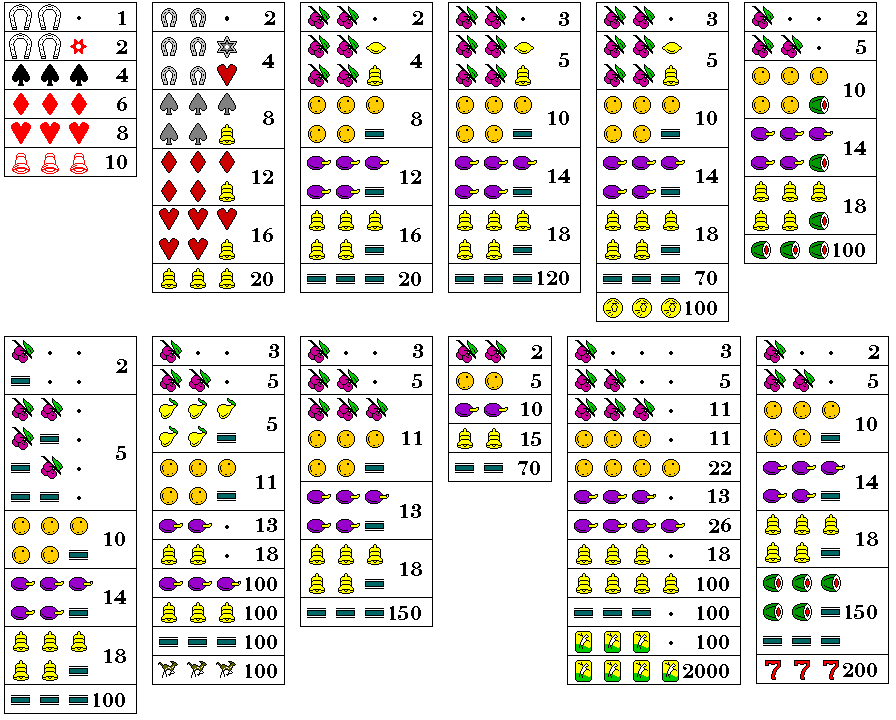
Today, when we think of a slot machine, one of the first things that comes to mind is the chance of winning the jackpot, and thus, a jackpot appears to be a necessary and essential feature of a slot machine, but the designs we have examined up to this point have all lacked one.
Marshall Fey (a grandson of Charles Fey, the inventor of the slot machine), in his book "Slot Machines: A History of the First 100 Years", notes that Watling produced a slot machine in 1920 that included a jackpot, but it did not become popular. He also notes that subsequently, Rock-Ola modified existing slot machines to add a jackpot starting in 1927, but it was after Caille, in 1928, introduced, and enjoyed success with, the Caille Superior Jackpot Bell that the other slot machine makers quickly followed suit. This led to the present situation, where a jackpot was something people expected from a slot machine, coming about in short order.
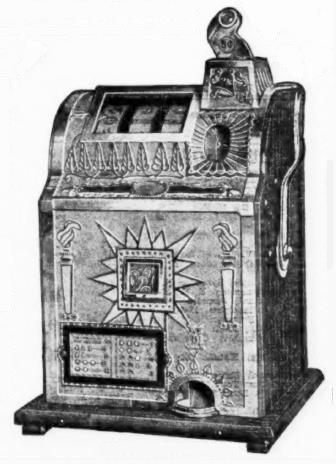
By 1929, however, Mills got around to making its own slot machines that already included a jackpot mechanism, as shown at left, rather than letting third-party companies make all the money from offering jackpot fronts to add to its existing machines.

On the right is pictured the 1938 model of the Watling Rol-A-Top. This model features cherries rather than coins coming out of the horn of plenty, and it has a third jackpot window above the original two jackpot windows of the design.
Repeating the earlier image of slot machine payouts through the years for ease of reference:


The fourth set of payouts, increasing the prizes for three oranges, three plums, and three bells from 8, 12, and 16 to 10, 14, and 18 respectively, which soon became the standard of the industry, was introduced with the Mills Mystery slot machine from 1937, also known as the "Castle Front", illustrated at left, which also offered some extra "mystery" payouts not explicitly listed. (Some of the lemons on the first reel were treated as cherries, those were the mystery payouts.)
The prize for two cherries was also increased from 2 to 3, and the prize for two cherries and either a lemon or a bell was increased from 4 to 5. These increased payouts also became common on competing slot machines, but there the older 2/4 payouts continued to coexist with the more generous 3/5 payouts; this was particularly true after single-cherry pay was introduced.
This set of payouts is that discussed in the example on the page on probability. This was the standard set of payouts for a slot machine; for many years prior to World War II, nearly every slot machine made used those payouts. Three bars paid 20 coins plus the jackpot, depicted here as 100 coins.
Since the amount of the jackpot may vary due to how long it has been since the most recent previous jackpot has been won, of course this may be an oversimplification.
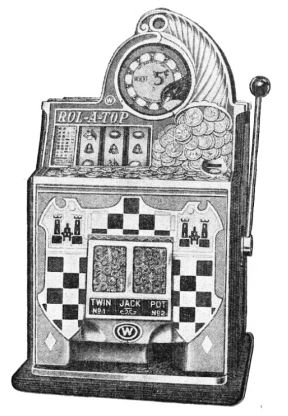
Speaking of mysteries, what must people have thought in November, 1948, when the new version of Watling's venerable Rol-a-Top slot machine, pictured at right, appeared?
Although it would only be on July 25, 1950 that the Korean War would start, with an invasion of South Korea by North Korea, and it was only in September, 1949 that President Truman announced to the American people that the Soviet Union had the atomic bomb, conserving metal for defense purposes, with World War II having only recently concluded, and with some aspects of the Cold War dating from 1947 as the United States reacted to Russia's attempts to obtain political control of Eastern Europe, by using pieces from old Mills slot machine cases might not have been seen as either unreasonable or mysterious.
However, that only explains the left side of the front, and not the right side, so apparently this is a bizarre case of unabashed copying.
From the manual for the Jennings Chief slot machine, a typical way in which the jackpot is filled on a slot machine is this:
Coins paid into the machine are first placed in the machine's coin tube if that is not full. The coin tube is the source from which coins are counted out to pay awards of a fixed amount in the payout schedule, so ensuring that there are enough coins in it has the highest priority.
If a coin passes the coin tube, next it goes into the jackpot if that is not full.
If the jackpot is full, it goes into the reserve. After a jackpot is paid, the contents of the reserve go into the jackpot so that the machine is not left with an empty jackpot, which would not encourage players.
Finally, when both the jackpot and reserve are full, coins go into the machine's cash drawer, where they serve as the operator's income. Although it's not all profit yet, since occasionally it will be worthwhile refilling the reserve or the jackpot by hand.
In this scenario, where no time is lost in keeping the jackpot full, calculating the percentage as if jackpots always paid the full capacity of the machine's jackpot chamber is indeed a reasonable approximation.
For convenience, I will repeat the calculation for this example slot machine from the first page of this section here:
The arrangment of symbols on the reels for those payouts which has been cited in several books on gambling was:
(*) Lemons 3 - 4 (%) Cherries 7 7 - (O) Oranges 3 6 7 (@) Plums 5 1 5 (A) Bells 1 3 3 (=) Bars 1 3 1
designed for a machine with the schedule of payouts as depicted in the diagram above:
%%. 3 %%*, %%A 5 OOO, OO= 10 @@@, @@= 14 AAA, AA= 18 === 120
And the calculation of its return proceeds as follows:
Reel Combinations Value Amount
1 2 3 Paid
7 * 7 * 13 = 637 * 3 = 1911
7 * 7 * 7 = 343 * 5 = 1715
3 * 6 * 8 = 144 * 10 = 1440
5 * 1 * 6 = 30 * 14 = 420
1 * 3 * 4 = 12 * 18 = 216
1 * 3 * 1 = 3 * 120 = 360
----
6062
for a profit of 24.225%.
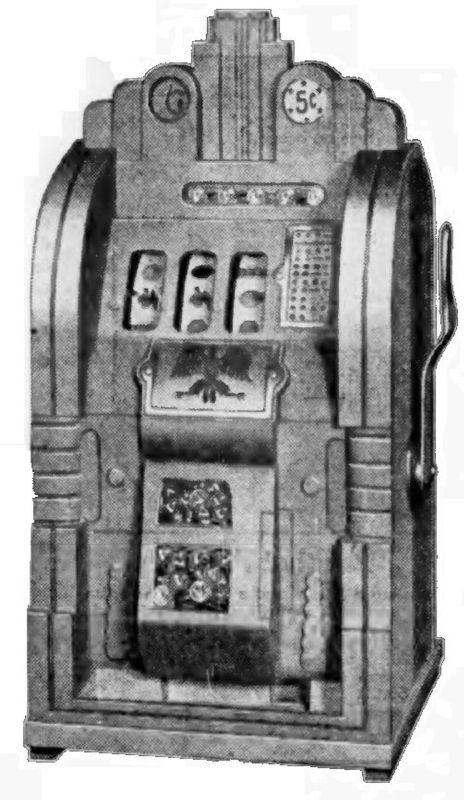
I have now found more information about where this particular example of a slot machine came from. This set of symbols on the reels is given in the book "The Facts of Slots" along with more detail: it belonged to a slot machine confiscated by the police that was then given to a statistics professor for legitimate use in education. This professor, Dr. Philip G. Fox, is shown in a newspaper photograph available online with a slide rule in his hand examining a Mills Extraordinary, like the one pictured at right; of course, I can not be certain if that is the machine mentioned in connection with this particular distribution of symbols on the reels.
This professor and his slot machine were also referenced in the April 14, 1945 issue of Billboard magazine.
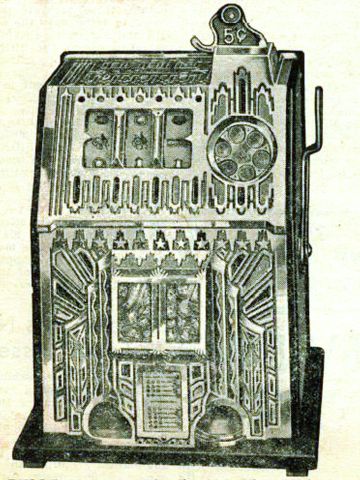
An actual machine, the Pace Comet, pictured at right, in at least one version, had a very similar arrangement.
The Pace Comet in the picture, called the Fancy Front, is from 1934, around the same time that Watling introduced its new Rol-a-Tor slot machine. The Watling Rol-a-Top, as it was soon to be named, had an elaborate rotary escalator that showed the last eight coins played (perhaps less for some denominations); Pace slot machines already, at least since 1926, had a smaller rotary escalator which showed the last four coins played.
The arrangement of symbols on the reels shown below is given on this page.
(*) Lemons 3 - 5 (%) Cherries 7 7 - (O) Oranges 3 6 6 (@) Plums 5 2 5 (A) Bells 1 3 3 (=) Bars 1 2 1

Another version of the Pace Comet, this time the All-Star Comet, from 1937, and contemporary with the Pace Kitty, to be discussed below, is shown at right.
With this arrangement, and the following similar payout schedule:
%%. 3 %%*, %%A 5 OOO, OO= 10 @@@, @@= 14 AAA, AA= 18 === 150
we can calculate its percentage:
Reel Combinations Value Amount
1 2 3 Paid
7 * 7 * 12 = 588 * 3 = 1764
7 * 7 * 8 = 392 * 5 = 1960
3 * 6 * 7 = 126 * 10 = 1260
5 * 2 * 6 = 60 * 14 = 840
1 * 3 * 4 = 12 * 18 = 216
1 * 2 * 1 = 2 * 150 = 300
----
6340
for a profit of 20.75%.
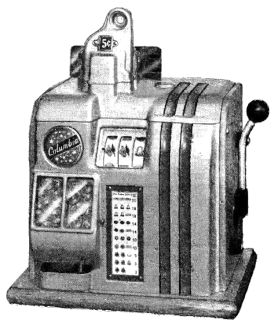
Even this more generous set of payouts does not strictly require having 20 positions on each reel, as can be illustrated through the example of the Groetchen Columbia (pictured at right):
(*) Lemons 3 - 3 (%) Cherries 2 5 - (O) Oranges 2 2 2 (@) Plums 1 1 3 (A) Bells 1 1 1 (=) Bars 1 1 1
Note that the arrangement of symbols on it is very similar to that on the Little Duke, altered only by replacing one cherry on the first wheel by a lemon! The fraction of the money spent on the machine that is returned in prizes can be calculated as follows:
Reel Combinations Value Amount
1 2 3 Paid
2 * 5 * 10 = 100 * 3 = 300
2 * 5 * 4 = 40 * 5 = 200
2 * 2 * 3 = 12 * 10 = 120
1 * 1 * 4 = 4 * 14 = 56
1 * 1 * 2 = 2 * 16 = 32
1 * 1 * 1 = 1 * 20 = 120
----
826
Thus, it would still be profitable even if the jackpot averaged 100 coins; in practice, jackpots were no doubt smaller.
The Mills SP set of reel strips is also similar to this:
(*) Lemons 3 - 5 (%) Cherries 7 7 - (O) Oranges 3 6 6 (@) Plums 5 2 5 (A) Bells 1 3 3 (=) Bars 1 2 1
in fact, it is identical to what was found on the version of the Pace Comet cited above.
The Mills Mystery slot machine, however, also had additional mystery payouts. The mystery payout was that two of the three lemons on the first reel actually behaved as if they were cherries. So, if it used the Mills SP reel strips, we can calculate what it would actually have paid:
Reel Combinations Value Amount
1 2 3 Paid
7 * 7 * 12 = 588 * 3 = 1764
7 * 7 * 8 = 392 * 5 = 1960
3 * 6 * 7 = 126 * 10 = 1260
5 * 2 * 6 = 60 * 14 = 840
1 * 3 * 4 = 12 * 18 = 216
1 * 2 * 1 = 2 * 120 = 240
----
6280
Mystery pays:
2 * 7 * 12 = 168 * 3 = 504
2 * 7 * 8 = 112 * 5 = 560
----
7344
So instead of paying out only 6280 coins out of every 8000, it also paid out an additional 1064 coins, for a total of 7344 coins and a payout percentage of 91.8%, leading to a house advantage of 8.2%.
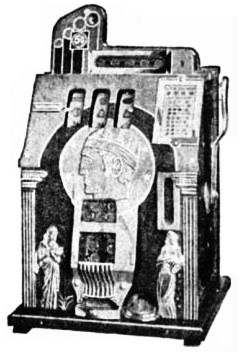
The fifth set of payouts is for the Mills Golden Bell slot machine, sometimes referred to as the Mills Roman Head, pictured at left. This is one of the first machines to introduce an extra symbol which stood for an additional jackpot. The machine dispensed a brass token which was then redeemed by the operator for this additional payout, called the Gold Award, which was therefore of a fixed size, unlike normal jackpots.
As for the normal jackpot, I've stumbled upon an early advertisement for the Mills Golden Bell slot machine which gives detailed information about its regular jackpots. The capacity of the jackpot compartment depended on the size of the coin the machine was handling, as is not unreasonable. Thus, it could handle 96 nickels ($4.80), 104 dimes ($10.40), or 84 quarters ($21.00).

This innovation was soom adopted by some other slot machine makers, particularly by Watling, which, from 1934 through 1949 manufactured the Watling Rol-a-Top slot machine. This is considered to be one of the most beautiful slot machines ever made, thanks to its elaborate circular coin escalator (the part that shows the last few coins played to help prevent the use of slugs).
Actually, when it first came out at the end of 1934, it was called the Rol-a-Tor, but within a few months its name was changed. Although apparently there is no documentary evidence in the matter, it is generally assumed that this was because the original name was too reminiscent of the Norge Rollator refrigerator, popular at the time. Thus, at the right, the Watling Rol-a-Top slot machine is shown in all its glory, along with a version of the original Rol-a-Tor where a vendor front covers part of the case. In addition, to the left of the image, the Watling Treasury, very similar to the Rol-a-Top, except for the lack of the large coin escalator, is shown for comparison.
While the Rol-a-Tor, with minor variations, continued to be sold until 1949, in late 1938 Watling appears to have discontinued production of the Treasury; one advertisement stated that they had only 45 machines remaining in stock.
In addition to the two columns of mints on either side of the jackpot compartment, it may be noted that the eagle in the case design is replaced by something above the jackpot compartment. And that is the window through which the machine's supply of Gold Award tokens is displayed, so the vendor model shown here is one with the Gold Award feature under discussion.
The Mills Golden Bell has a similar window; it can be seen to the right of the gold coin motif in the center of the case, starting from its vertical center, and extending down to the head of the female figure on the right at the bottom of the case.
Or, to make it simple, rather than requiring the reader to follow lengthy verbal descriptions in each case, here are the Mills Golden Bell and the Watling Rol-a-Tor again, but this time with the Gold Award Token windows highlighted in yellow in each one:

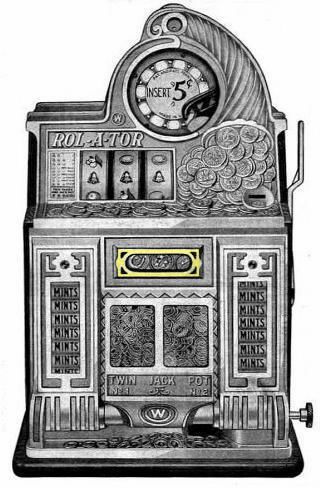

And following those two images is one of the Watling Gold Award slot machine from 1934, as this did predate the Rol-a-Top. No highlighting was performed on that illustration, but the window displaying the Gold Award tokens is in the same position as on the Rol-a-Tor vendor. (The small size of the image is due to the source image being of poorer quality, not because it is a smaller machine.)
Jennings also made slot machines which had a symbol representing the token given out to be redeemed for an additional fixed large prize; while Watling also used the term "Gold Award", and Pace did as well, Jennings term for a prize tokens was "Prosperity Token", which, of course, would be an appropriate name to use during the Great Depression.
The illustration below
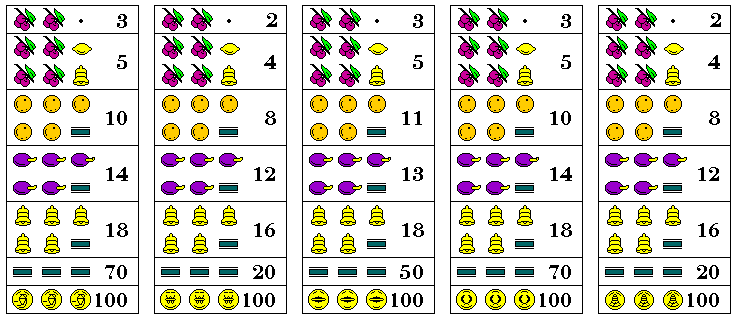
shows the payouts for the Mills, Watling, Jennings, Pace and Superior Confection machines with gold award tokens in order, from left to right. The Mills and Pace machines had the same payout scheme, with three bars awarding both a normal jackpot and the constant prize of 20 coins together; the Jennings machine just awarded a jackpot, and the Watling machine apparently did not also award a jackpot on three bars.

The fifth payout schedule is from a machine by the Superior Confection Company. Here, the Gold Award token bears a Liberty Bell symbol on it. Although the payout schedule follows that of the Watling machine in the illustration, the payout card shows the style of Gold Award token used in a Mills machine, which suggests that some Mills Gold Award machines also used that payout schedule. Many of this company's machines were made from parts from both Watling and Mills slot machines, and on some of them, it is printed on the case that they were built for the company by Charles H. Fey and Company. Machines by the Superior Confection Company are quite rare, and are highly prized by slot machine collectors. One unique machine of theirs had a conventional slot machine mechanism oriented so as to use carousel-like reels with colored silhouettes of race horses.
The machine did have a jackpot window, so it is possible that three bars did award a jackpot in addition to the basic prize of 20 coins.

On the right is shown the payout schedule for another machine by the Superior Confection Company from 1934 or 1935 that had a "Gold Award" symbol on its reels, the Special Mystery, but it's not clear if an actual token was involved in this machine's payouts, since all the combinations of a bar and a gold award symbol are stated to pay the jackpot, and the machine has a jackpot window.
However, the machine pictured at left has both a pair of jackpot windows, and a token window immediately above the jackpot windows, in addition to an escalator above the reels (which makes it completely unambiguous that there is also a token window present).
Since the Gold Award token had an image of a Liberty Bell on it, I suppose that it was decided to have the Gold Award symbol, as well as the lemon and the bell, complete the 5-coin combination with two cherries to prevent confusion and arguments.
The only difference between the payout diagrams for Mills and Pace are that the former represents a token with an image of an amphora, and the latter a token with an image of a wreath. The actual Pace tokens, though, do not seem to have resembled the symbol used, unlike the case for the other three manufacturers.
These are just the makers of slot machines that used a symbol which was an image of the prize token on the reels of their slot machines; the use of a token for a prize payout is common, being one of the standard options in slot machine design. Later on, when guaranteed jackpots were paid by attendants in casinos, with tokens not being involved, the Gold Award symbol of a coin was replaced by other jackpot symbols such as the 7 or the melon, but even so, it can be considered to be their ancestor.
Watling's original design for its gold award token was somewhat unfortunate: on one side, it included a horseshoe... and another good luck symbol, this being one used by Native Americans, and which also had positive religious meaning in India. Unfortunately, it also was used as the symbol of a certain German political movement which fell into deserved disrepute.
Arbitrarily, the jackpot for three bars is depicted as 50 coins; winning the Gold Award provided either a larger jackpot, or a token redeemable for 100 times the amount wagered on different machines made by Mills with the new symbol.
The version of this machine with a low percentage had the following arrangement of symbols:
(*) Lemons - - 3 (%) Cherries 8 7 - (O) Oranges 3 4 5 (@) Plums 2 4 5 (A) Bells 2 3 4 (=) Bars 3 1 2 (o) Coins 2 1 1
an alternate version replaced two of the cherries, and one bar, on the first reel with lemons.
Given the payouts of
%%. 3 %%*, %%A 5 OOO, OO= 10 @@@, @@= 14 AAA, AA= 18 === 70 ooo 120
we can calculate how many coins this paid out for each 8000 coins put in, on average:
Reel Combinations Value Amount
1 2 3 Paid
8 * 7 * 13 = 728 * 3 = 2184
8 * 7 * 7 = 392 * 5 = 1960
3 * 4 * 7 = 84 * 10 = 840
2 * 4 * 7 = 56 * 14 = 784
2 * 3 * 6 = 36 * 20 = 720
3 * 1 * 2 = 6 * 70 = 420
2 * 1 * 1 = 2 * 120 = 240
----
7148
for a profit of 10.65%.

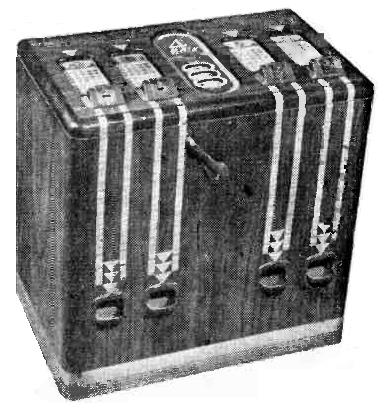
Although companies like Bally and Keeny were the best-known makers of console slot machines, while Mills was mostly famous for its regular slot machines, Mills also made console machines. One machine of theirs, illustrated at left, which did something interesting with its payout schedule was their "Four Bells" console.
One set of three reels showed the combination of symbols which might indicate a prize will be awarded, as on a conventional slot machine.
But the player had a choice of four different coin slots in which to wager, each one giving a different playout schedule.
Essentially, starting from a conventional slot machine payout schedule, one could choose to double the payout on a combination of oranges by using the first slot, or to double the payout on a combination of plums by using the second slot, or to double the payout on a combination of bells by using the third slot... or to triple the size of the jackpot payout by using the fourth slot.
Note that the payout for two cherries is 2, and the payout for two cherries and a lemon or a bell is 4, as on older slot machines, but the basic payouts for the orange, plum, and bell are 10, 14, and 18 respectively, the larger payouts introduced with the Mills Mystery.
So, let us start with the Mills SP set of reel strips, designed for use with the smallest payouts being 3 and 5, and work out what it would pay with them reduced to 2 and 4, and with 60 coins being paid for three bars.
Reel Combinations Value Amount
1 2 3 Paid
7 * 7 * 12 = 588 * 2 = 1176
7 * 7 * 8 = 392 * 4 = 1568
3 * 6 * 7 = 126 * 10 = 1260
5 * 2 * 6 = 60 * 14 = 840
1 * 3 * 4 = 12 * 18 = 216
1 * 2 * 1 = 2 * 60 = 120
----
5780
If the amount paid for three oranges, or two oranges and a bar, was doubled, then add 1260 coins to the amount paid, for 7040 coins out of 8000.
If the amount paid for three plums, or two plums and a bar, was doubled, then add 840 coins to the amount paid, for 6620 coins out of 8000.
If the amount paid for three bells, or two bells and a bar, was doubled, then add 216 coins to the amount paid, for 5996 coins out of 8000.
And, finally, if the amount paid for three bars was tripled, add 240 coins to the amount paid, for 6020 coins out of 8000.
Thus, the SP set of reel strips would be sufficient to lead to profitability for the machine, although it would have been better to use a customized set of reel strips that led to the house advantage for the four options presented to the player being more equal.
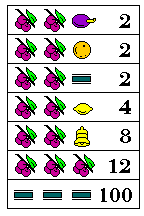
Some older slot machines, to lower costs, used simplified arrangements.
Thus, the Mills QT (and the Mills Junior Silent, on which it was based) paid out only when two cherries appeared on the first two reels, with the prize determined by the symbol on the final reel, except for the jackpot which was still paid on three bars.
That machine's payout schedule is pictured at right, and using the symbols used above in the text, it was:
%%= 2 %%O 2 %%@ 2 %%* 4 %%A 8 %%% 12 === Jackpot
which could also be viewed as
%%. 2 %%* 4 %%A 8 %%% 12 === Jackpot
which suggests that the design is partly based on abbreviating the payout mechanism of a conventional slot machine, rather than on a simpler design of a completely different nature. Differentiating between the lemon, bell, and cherry on the third reel, though, still requires something additional.
The machine itself is pictured at right.

Small-sized machines like the Mills QT stopped being manufactured abruptly just prior to 1951. In the United States, up to that time, slot machines were commonly found in ordinary retail establishments, frequently even when this was in violation of local ordinances or even State laws. Very early in 1951, however, the Johnson Act took effect, a Federal law which not only imposed severe penalties for illegal slot machine operation, but also made their manufacturers responsible to only ship machines to those who could legally use them.
This meant that State laws restricting slot machines became effective; in addition to Nevada, only a few other states at the time permitted slot machines to be operated for gambling, two (Washington state and Montana) only in private clubs, Idaho permitted individual towns and cities to allow slot machines or not, and Louisiana, Tennessee and Alabama allowed them with a requirement for licensing with a fee.